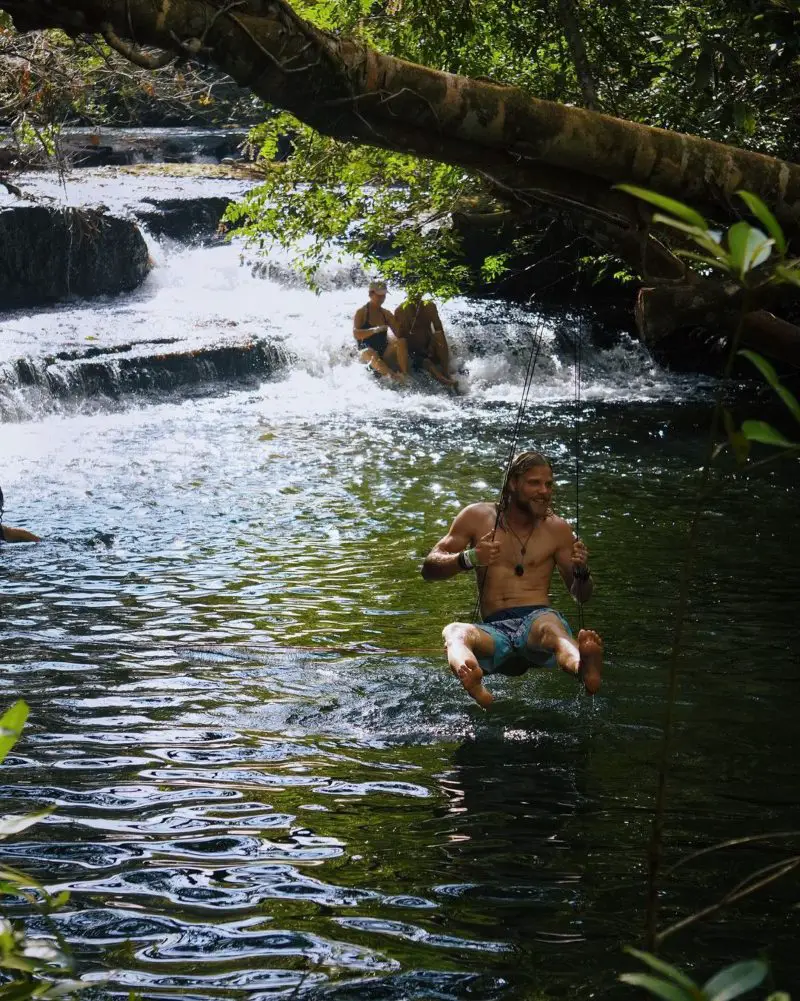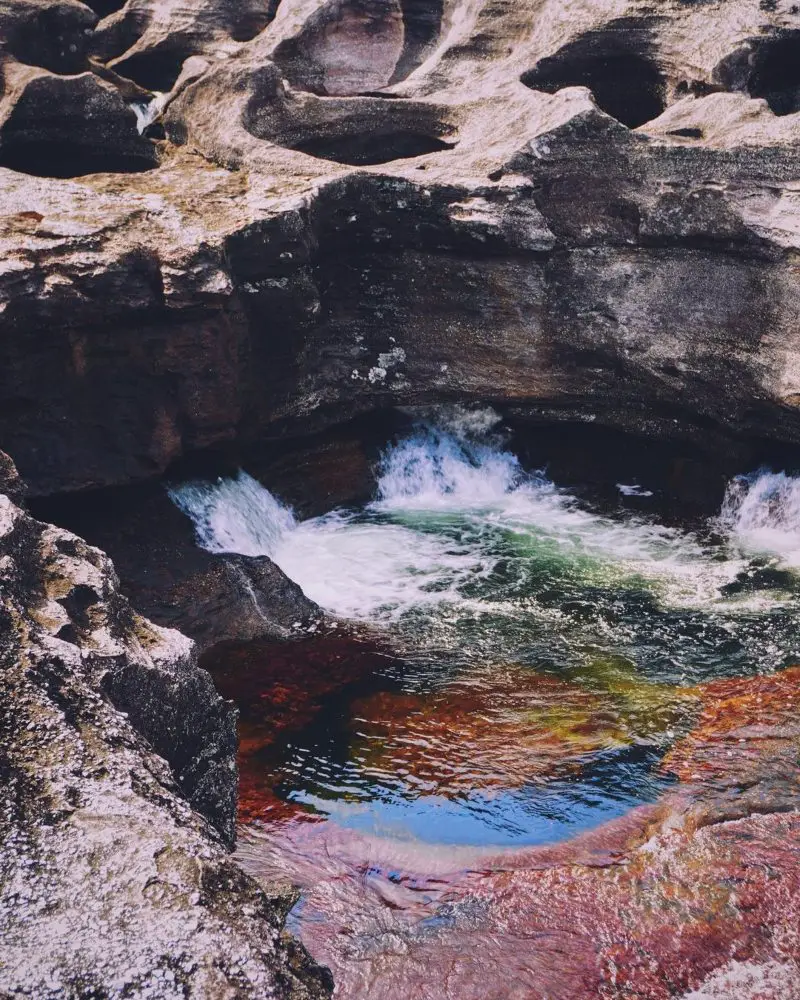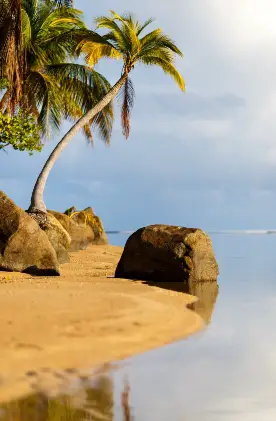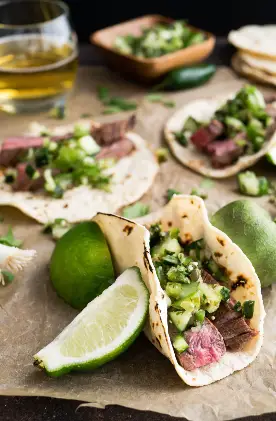We are Stefan & Rebecca. Welcome to our Cano Cristales guide! We hail from Zurich, the German-speaking part of Switzerland. We love communication, so we studied communication with a focus on journalism. Our range of interests and our curiosity not only led us to journalism, but also gave us a passion for traveling – as it lets you immerse in the unknown with new cultures, exciting stories and wild adventures to be experienced.
Rebecca has always worked in jobs related to travel, and Stefan had his first experience abroad when he was 16 and immediately got fascinated with it. Stefan knew he wanted to continue traveling for the rest of his life, which led him to explore Colombia seven years ago – raving about it to Rebecca as one of the most diverse countries in South America. So, it was clear that Rebecca also yearned to discover Colombia for herself.
Three Incredible Months Traveling in Colombia
Recently, we spent a total of almost three months in Colombia. Starting in Leticia (we came by boat over the Amazon from Brazil), we then flew by plane to Cali. From there, we traveled from Popayan to Pasto and on to Ecuador. More than half of our time in Ecuador was spent in the jungle at an animal sanctuary. Afterwards, we returned back to Colombia in August.
This time, however, we ventured from Pasto to Mocoa. This region isn’t touristy but it was beautiful. We also heard about San Agustin and wanted to see the carvings and tombs with our own eyes. When we realized the Tatacoa Desert wasn’t too far away, next we took a detour to Villavieja, which turned out to be worth it. And that’s when we had the idea of heading towards La Macarena (home to Cano Cristales) by bus.
After asking around and comparing buses, we boarded the first bus to San Vicente del Caguan from Neiva. From San Vicente, we traveled by jeep until we arrived in La Macarena – and couldn’t wait to see Cano Cristales. Following our time in La Macarena, we returned to Neiva and from there to Bogota. Here, we met up with Rebecca’s friend and did the usual itinerary with her: Salento, Jardin, Medellin, Santa Marta and Palomino.
Stefan then went up to the northernmost point of South America, to Punta Gallinas, while the girls stayed at the beach. Then Rebecca’s friend left and it was the two of us again. We visited Minca and things got adventurous. First we stopped in Cartagena and looked for a boat that would take us to Panama. We found one but the journey started in Sapzurro. So, we made our way to the border. In between, we stopped in Rincon del Mar, Necocli and Capurgana before leaving Colombia with a heavy heart.



A Truly Unique Experience in Cano Cristales
Stefan can’t remember how he heard about Cano Cristales. As a child, he watched a lot of documentaries about different places – much of what he saw remains in his mind today and continues to inspire his travels. Stefan wanted to go to Cano Cristales seven years ago but it didn’t fit into his itinerary. It was also more dangerous back then due to the civil war and the guerrillas controlling the area. But this time, he couldn’t miss it. We asked people how to get there and surprisingly even Colombians didn’t know.
We ended up staying in the Cano Cristales area for five days and joined a few tours. Around La Macarena, there are two different national parks: Tinigua and Sierra de La Macarena. We explored both. The Rainbow River was the highlight for us but there’s definitely more than just that place on offer. On the first day, we visited a smaller river that also had the aquatic plant “Macarenia Clavigera” – which gives the rivers their different colors.
This plant is so cool. We experienced the driest desert in the world, the Atacama, when it was full of flowers – only occurring for a short period of time every five to seven years. And for us, the “Macarenia Clavigera” is on the same level as these desert flowers. When we visited Cano Cristales, we were unlucky with the weather and unfortunately the colors of the river were a bit hidden (they only appear when the sun is shining).
Luckily, we went back to Cano Cristales and saw the river in all its colors. But, as mentioned previously, there is more to see than just the river: you can see special stone formations, take river tours and explore the jungle. One of the highlights for us was witnessing the diversity of species in the area. Here you can spot monkeys, crocodiles, turtles, butterflies and capybaras. Wild animals are literally everywhere because the region is so remote. We also saw the most beautiful moth (check out the photo below).



Guided Tours to Cano Cristales are Required
As far as we know, you can’t enter the parks surrounding Cano Cristales by yourself. We wanted to do it and asked if we could, but we had to go with a guide. So, we booked our trip with Jesus from Guaya Ecotours. I think it was the cheapest option and it was cute because we were the only ones who experienced it like this. Most people book an all-inclusive package with flights. But with Jesus, we got a girl who was our guide for the village – she took us around by bike, organized our food and was very kind.
Best Things To Do in the Cano Cristales Area
1. Visit Cano Cristalitos First
As mentioned before, we did Cano Cristalitos first. This is a small river and only takes half a day. It costs around 40 dollars. You can see the water plants and go swimming. Watching the sunset here from a plateau is a must-do, in addition to spotting animals. It makes sense to see this gem before the famous Cano Cristales, since it wouldn’t be as impressive after seeing the main river first. Think of it as the warm-up to the main event.
2. Marvel at the Colorful Cano Cristales
The next natural attraction we did was Cano Cristales. We ventured on a full day tour which cost us around 57 dollars. On this adventure you go hiking, see the famous river, visit nice waterfalls and explore the whole park in general. The nature here is different to anywhere else on Earth. It was amazing. Lots of endemic plants grow here. That is all we can reveal about its beauty, as you have to see it for yourself to get a better understanding.



3. Do the Raudal de Angosturas Tour
The last tour we did was Raudal de Angosturas. It’s a day trip for around 57 dollars. You take a boat trip for about two hours upstream and from the river you get to see a variety of animals. After that, you hike for two hours to encounter natural pools and small rivers with the famous water plant. Then you end up in a stone labyrinth made by nature but it looks like an ancient city. You can even climb the stones and look out over the national park.

Our Highlights from this Special Destination
These are the three tours we did but there are many more things to do around Cano Cristales. In general you can do a lot of birdwatching, hiking, swimming and learning about the culture of the Llaneros – their music, dance, relationship with horses and so on. Also, the nature along the way to La Macarena, outside of the national parks, is amazing. So, if you have the time, you can just drive for hours and marvel at the nature around you.
For us, the highlight was seeing the wild animals – capybaras, monkeys, snakes and birds – and obviously the river itself. There’s nothing comparable. But one evening we went to eat in a restaurant where we sat at huge tables, and the Llaneros played live music all evening and everyone danced to it. First it was professional dancers, then those who are still practicing and finally all the guests. The way they played the harp and danced together was beautiful. The people here are warm and full of joy.



Accommodation Options in Cano Cristales
We stayed at Posada Los Cristales and paid around 10 dollars per night for a private room with AC. We are backpackers of course, trying to travel around the world, so we didn’t have a big budget. But there are a couple of bigger and nicer hotels that you can book. In general, La Macarena is small and perhaps only 5,000 people live there – so there aren’t too many options.
Important Tips for Your Trip to Cano Cristales
Cano Cristales is the name of the river in Colombia known for its incredibly unique colors, earning it the nickname “The River of Five Colors”. It’s located in Serrania de la Macarena National Park and features a rainbow of black, blue, red, green and yellow colors that are at their best from May to November. Between November and May you won’t find a single tourist in La Macarena, which is a shame, but the people are trying to develop the offering to a year-round one (as there’s lots to see here).
Regarding packing and weather, it’s important to know that the ecosystem here – especially the endemic aquatic plants that give the rivers their colors – is very fragile. It’s not permissible to use sunscreen or insect repellent. The people make that clear. You have to listen to a presentation about it before you’re allowed to enter the park. The weather, though, is sunny and hot. You should bring long clothes that are breathable.
Additionally, if you don’t book an all inclusive package, you should know some Spanish since no one speaks English. You have to pay tourist taxes of 55 dollars if you want to enter the park. You’ll get a wristband and cannot go alone. Perhaps the most important tip is how to get to La Macarena, as this was the part we struggled with the most. Most people take a flight from Bogota but this was too expensive for us. Instead, we tried to get there by land and had a hard time finding reliable information.
Here is how we did it. We took a bus at midnight from Neiva to San Vicente del Caguan, arriving at 10am. From there, we took the last jeep at 1pm to La Macarena. There’s another route from Bogota via Villavicencio, however, this one was blocked due to a collapsed bridge. So you should get informed on the roads since they’re unpaved and conditions can change. To get back to Neiva, we took another route that was faster and we didn’t have to stop. But it was 10 hours in the back of a jeep on unpaved roads!


























